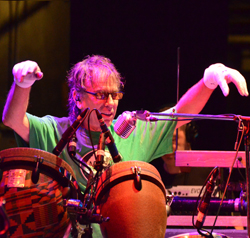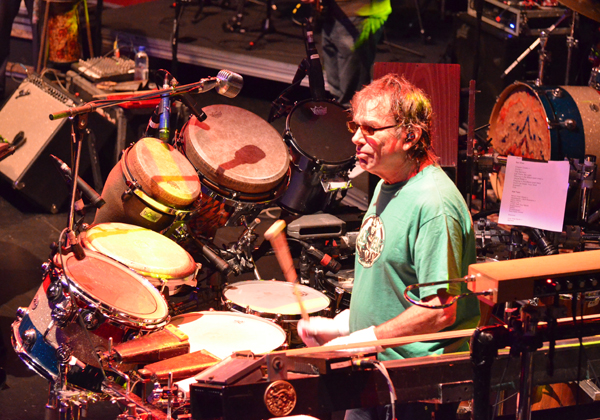
Plenty Of Variety
Hart’s percussion rig is the most complex beast on stage. “It’s mounted on a drum cage, is very intricate and changes every few days,” Topazio says. A variety of percussion instruments at the front of the kit, as well as Hart’s practice congas and timbales are mic’d wide with a pair of SM57s run into one channel for each instrument.
Audix D4 dynamics are deployed for djembe, a rack-mounted cajón and two small legros, with Audix D6s used for the largest legro – a roughly 20-inch instrument with the sonic character of a kick drum – and for Hart’s signature instrument, a pedal=operated talking drum. Hart’s dumbek gets an Audix I5, which Topazio refers to as “the Swiss Army knife of microphones” owing to its versatility.
The remainder of the kit is miked with Sennheiser: an e609 on a 14-inch rack tom, an MD 421 for ton ton and an e604 on a marching snare, which, with it’s Kevlar head and open bottom, is the ‘bossiest’ of Hart’s instruments. “It’s been clocked at 127 dB without a mic and doesn’t really need one,” Topazio says, “but we use an e604 on it.”
Then there’s the Random Access Music Universe (RAMU) side of the kit: electronic instruments, MIDI controllers and sound generators, a theramin running through a variety of FX pedals and a 13-string monochord instrument called The Beam that Hart plays with a bow, a steel bar and drum sticks, which also interfaces with the theramin.
The entire kit is fed to Sharp’s Ableton rig, including the EEG ‘brain cap’ that requires six lines out on its own. Sharp then uses Ableton software and a dedicated effects console, a 32-channel Midas Venice F, to manipulate the sound of the kit further. “That console connects via FireWire to Ableton,” Topazio says, “then Jonah sends me stereo left and right.”
For his monitor mixes, Topazio has an Avid SC48 console outfitted with an X-Net card for connections to a remote stage box over Cat-5, and an A-Net card to interface with the Aviom system. At FOH, there’s a Midas PRO2 supplied by Topazio’s company. IEM earpieces for the band include Ultimate Ears UE 5, UE 7 and UE 4, Shure SE315s and custom molds.
Both Hart and Shutte, however, want to feel the bottom end as well as hear it. For Shutte this is accomplished with a Buttkicker Concert Series shaker. For Hart, owing to the size and setup of his kit, has four Buttkickers mounted on a 3- x 8-foot, roughly 2-inch-high riser, to which Topazio sends kick, bass DI, both Talking Drums, the large legro, The Beam, and the low end of Sharp’s RAMU rig.
Delving Deep
A central challenge of the gig is getting Hart’s mix right, a situation impacted by both the eclectic mix of instruments and the fact that Hart has sustained damage to his hearing during his decades with The Grateful Dead.
“He’s missing some high end so I have a graphic EQ inserted on his outputs,” Topazio says. “I’ll be listening and think ‘I have to take some high end off,’ but I stop myself because that’s what he needs. Getting clarity, getting the gates to close and getting my compressors to work with all the effects that he wants is also challenging.
“At the same time, when Jonah is doing all the dubbing out of Mickey’s drums, I have to bring what we would call the dry signal down so Mickey can hear the Ableton rig.”
It requires constant collaboration between Topazio, Sharp, backline technician Alex McCraw and Hart’s drum tech, Mark Alspaugh, who’s listening to the same mix as Topazio. “It’s the kind of situation requiring a solution you have to take the time to work through,” he concludes, “but I really enjoy delving deep and spending time behind the console thinking, ‘how do I make this better?’ It’s constantly changing.”
Based in Toronto, Kevin Young is a freelance music and tech writer, professional musician and composer.

